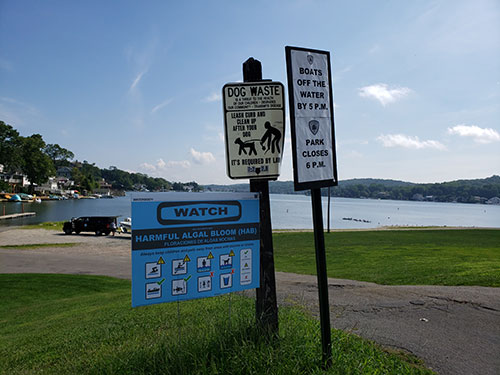 |
HABs in Drinking Water Supplies
 Cyanobacteria, often referred to as “blue-green algae” are a photosynthesizing bacteria found in freshwater systems, estuarine and marine waters in the U.S. Cyanobacteria can impede activities like swimming, fishing, and even impact drinking water. Cyanobacterial Harmful Algal Blooms (HABs) is the name given to excessive growth of cyanobacteria which occurs under suitable conditions (light temperature, nutrients, and calm water), which can produce a thick brown or green mat-like layer on the water. Some HABs can produce highly potent toxins, known as cyanotoxins. Cyanotoxins are produced and contained within the cyanobacterial cells (intracellular) and have adverse health effects. The release of these toxins in an algal bloom into the surrounding water occurs mostly during cell death and lysis (i.e., cell rupture). Cyanotoxins can have adverse health effects. Recreational Waters and Drinking Water sources can both be impacted by Harmful Algal Blooms and should be monitored for signs of a bloom. Cyanobacteria, often referred to as “blue-green algae” are a photosynthesizing bacteria found in freshwater systems, estuarine and marine waters in the U.S. Cyanobacteria can impede activities like swimming, fishing, and even impact drinking water. Cyanobacterial Harmful Algal Blooms (HABs) is the name given to excessive growth of cyanobacteria which occurs under suitable conditions (light temperature, nutrients, and calm water), which can produce a thick brown or green mat-like layer on the water. Some HABs can produce highly potent toxins, known as cyanotoxins. Cyanotoxins are produced and contained within the cyanobacterial cells (intracellular) and have adverse health effects. The release of these toxins in an algal bloom into the surrounding water occurs mostly during cell death and lysis (i.e., cell rupture). Cyanotoxins can have adverse health effects. Recreational Waters and Drinking Water sources can both be impacted by Harmful Algal Blooms and should be monitored for signs of a bloom.
Water systems with surface water supplies tend to be the most vulnerable, but certain groundwater sources, such as those identified as being under the direct influence of surface water (GWUDI) may also be susceptible to HABs. Historically, algal blooms have been known risks for public water systems due to the taste and odor effects they can have on water supplies. More recently, the degree to which cyanotoxins can enter drinking water supplies has been better understood and requires further attention than they were previously given. Due to the possible lysing of cyanobacteria, and the subsequent release of cyanotoxins in certain conventional treatment processes, some systems may experience difficulty in addressing these compounds. Therefore, it is recommended that systems become familiar with risks to their own source water and begin the planning process to address HABs if they occur.
If you suspect a water body to be experiencing an HAB, particularly if it is a drinking water source, report it to the DEP Hotline (1-877-WARNDEP(927-6337)) or download the WARN NJDEP mobile app from iTunes, Google Play or Windows Phone. These are the only means of notifying DEP of a suspected HAB. For more information about identifying HABs, view the Department’s central web page on HABs at www.state.nj.us/dep/hab/.
Helpful Links for Drinking Water Systems
Public Notification for Drinking Water Systems
Consumer Health Information
More Information on HABs
|